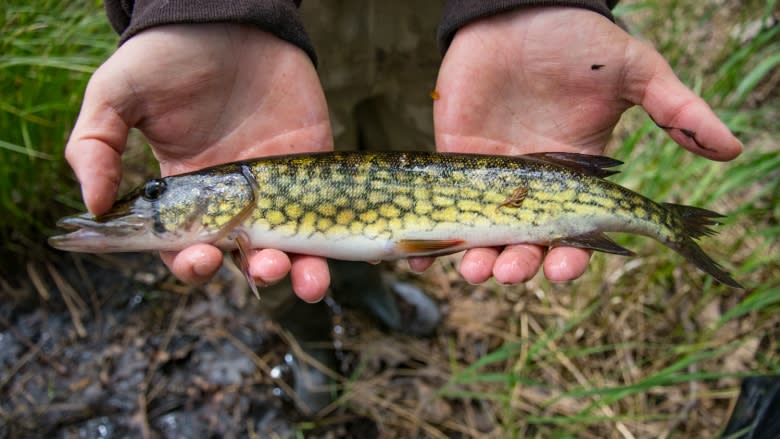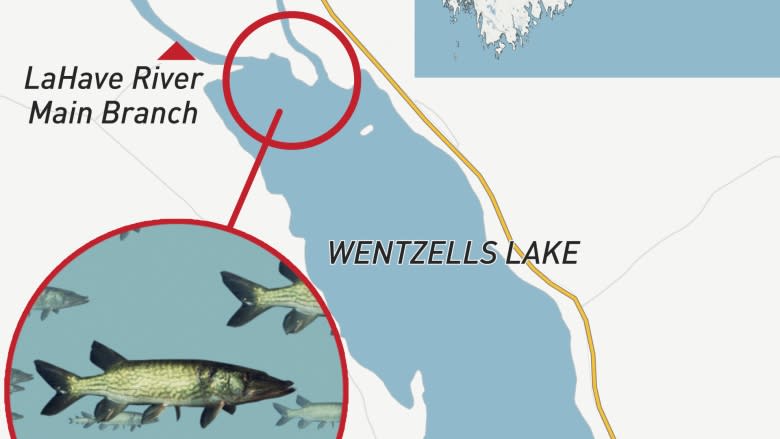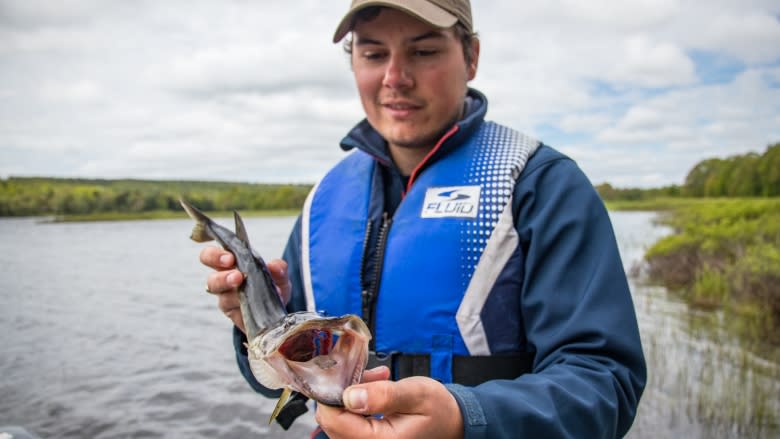Chain pickerel invade critical Nova Scotia salmon habitat
A new and potentially devastating threat to Atlantic salmon is emerging in the LaHave River on Nova Scotia's South Shore.
A research study this spring shows chain pickerel — an invasive species — are intercepting and eating salmon smolts as they migrate out to sea.
"It's actually very alarming when we see four smolts in one pickerel," said Shawn Feener, co-ordinator of the LaHave River invasive species project.
In late April and early May, Feener and a colleague from the Bluenose Coastal Action Foundation began collecting chain pickerel at Wentzells Lake where the north branch of the LaHave meets the river's main branch.
Pickerel are an aggressive marine predator often described as freshwater barracuda.
The $50,000 study, mostly funded by LaHave River Salmon Association, was timed to coincide with the spring run of salmon smolts out of the river to the ocean.
During that time, Feener and a technician opened up 100 pickerel and inspected their stomachs to find out what they were eating.
"About a quarter of the stomach analysis was fish. And of that quarter, about 40 per cent of that was Atlantic salmon smolt. So when the Atlantic salmon smolt are migrating, it does contribute to a large portion of the diet," said Feener.
"The chain pickerel being introduced here is just another factor inhibiting the survival of the Atlantic salmon."
The LaHave salmon population is already in trouble for the same reasons the fish is struggling in other areas of mainland Nova Scotia. They include acidification of their marine habitats, illegal fishing and at-sea mortality.
Salmon returns on the LaHave are down more than 90 per cent since the 1980s, says the Department of Fisheries and Oceans.
In 2015, only 179 salmon were counted at the fish ladder on Morgan Falls on the main river branch.
'Our species is in big trouble'
Angler Carroll Randall, a member of the LaHave River Salmon Association, helped the project by catching the chain pickerel. He recalls his reaction when he saw smolts coming out of their stomachs.
"We're in big trouble," he said.
"Our species is in big trouble because the smolt and parr are how the salmon population regenerates, and now we've got a predator in our river that is going to knock those numbers down drastically."
Chain pickerel are already suspected in an ecological catastrophe unfolding in the nearby Petite Riviere watershed, home to the world's only surviving population of the endangered Atlantic whitefish, an ancient relative of salmon.
After surviving in three landlocked lakes for a century, no adult whitefish have been seen since chain pickerel were found there in 2014. In the past two years, a few dozens larval whitefish have been trapped — a sign that at least some adults have survived.
For Feener, the results from the LaHave survey are a cautionary tale.
"I think the thing we really need to think about now is the movement of invasive species and introductions elsewhere, because there are rivers where we have somewhat healthy population of salmon smolt at least. If the chain pickerel are introduced into these rivers there is basically no hope."
The good news for now is that chain pickerel have not been confirmed in the main branch of the LaHave River above Morgan Falls, which produces most of the LaHave salmon smolts. But it's an area Feener says he will be examining now that the smolt run is over.





